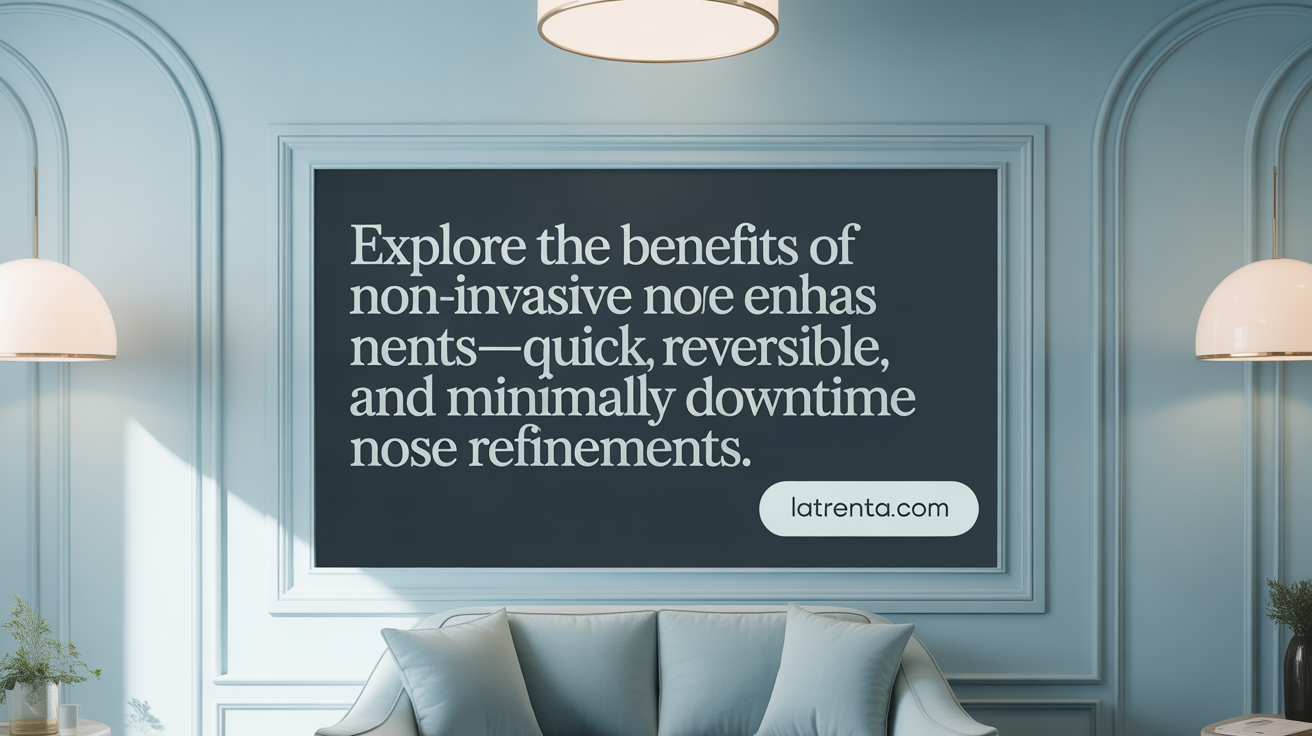Understanding a Modern Approach to Nose Enhancement
Nonsurgical rhinoplasty has emerged as a popular, minimally invasive cosmetic procedure designed to improve the shape and contours of the nose without the need for surgery. As an appealing alternative to traditional rhinoplasty, it offers immediate results with less downtime and reversible effects. This article delves into the nuances of nonsurgical rhinoplasty, identifying who it’s best suited for, explaining the step-by-step process, and setting realistic expectations about outcomes, benefits, and risks.
What Is Nonsurgical Rhinoplasty and How Does It Work?

Definition and overview of nonsurgical rhinoplasty
Nonsurgical rhinoplasty, also known as liquid rhinoplasty, is a minimally invasive cosmetic procedure designed to improve the shape and appearance of the nose using injectable dermal fillers. Unlike traditional rhinoplasty, which involves surgery, this method offers a quick, office-based treatment that can be completed in about 15 to 45 minutes, with almost no recovery time required.
Use of dermal fillers, primarily hyaluronic acid and calcium hydroxyapatite
The procedure primarily utilizes dermal fillers such as hyaluronic acid (HA) and calcium hydroxyapatite (CaHa). Hyaluronic acid-based fillers are the most common because they are reversible with hyaluronidase if necessary. These substances are injected into targeted nasal areas to add volume, smooth irregularities, lift the nasal tip, and camouflage bumps or asymmetries.
Injection technique and targeted nasal areas
During the treatment, a qualified practitioner injects the chosen filler into specific regions such as the bridge, tip, or sides of the nose. The injection is carefully administered into avascular planes away from major blood vessels to minimize risk. Techniques include injecting small amounts gradually with fine needles or cannulas, aiming to enhance nasal contours and correct minor irregularities.
Procedure duration and setting
Most nonsurgical rhinoplasty sessions are completed within 15 to 30 minutes in a clinical setting. They’re designed to be quick and convenient, allowing patients to often return to their daily activities immediately after the procedure.
Temporary nature and reversibility of results
The effects of nonsurgical rhinoplasty are temporary, generally lasting from four months up to around two years depending on the filler used, individual metabolism, and lifestyle factors. If a patient is unhappy with the results, hyaluronic acid fillers can be reversed with an enzyme called hyaluronidase. Regular touch-ups help maintain the desired appearance.
Comparison to surgical intervention in terms of invasiveness and recovery
Compared to surgical rhinoplasty, nonsurgical rhinoplasty is less invasive, involving no incisions, anesthesia, or extensive downtime. Surgical rhinoplasty provides permanent, more dramatic changes, but involves higher costs, longer recovery, and higher risks. Non-surgical options are ideal for subtle modifications, initial assessments, or temporary adjustments, making them suitable for those hesitant about or not ready for surgery.
Who Should Consider Nonsurgical Rhinoplasty? Identifying Ideal Candidates

Characteristics of suitable candidates
A suitable candidate for nonsurgical rhinoplasty is someone seeking minor aesthetic improvements of the nose without undergoing surgery. This outpatient procedure offers quick, visible results involving minimal downtime. Ideal candidates typically have mild nasal imperfections such as bumps, indentations, or a lack of tip projection. They may also want to smooth irregularities or slightly reshape the nose.
Patients should be in good overall health, without major structural or functional issues. Since the procedure's effects are temporary, candidates must understand that results last about six months, requiring maintenance treatments to sustain improvements.
Common nasal concerns addressed
Nonsurgical rhinoplasty effectively camouflages bumps on the bridge, lifts or refines the nasal tip, adds volume to low nasal bridges, and smooths contours. It can also correct minor asymmetries and irregularities resulting from previous procedures or natural nasal shape.
However, it cannot shrink or narrow the nose or fix breathing difficulties caused by structural issues like a deviated septum. For significant reshaping or structural corrections, traditional rhinoplasty remains necessary.
Limitations regarding structural and functional issues
This non-invasive technique is primarily designed for cosmetic enhancements and not for fixing nasal obstructions, breathing problems, or large deformities. It cannot reduce the overall size or width of the nose. Patients with complex structural concerns should consult a specialist for surgical options.
Temporary nature and realistic expectations
Results usually last from 4 months up to 2 years, depending on the filler type used. Patients should have realistic expectations about the scope of change — it provides subtle, non-permanent adjustments rather than dramatic transformations. Those seeking permanent change or addressing functional issues will need to consider surgical rhinoplasty.
Importance of provider expertise and patient health status
Choosing a board-certified, experienced practitioner is vital to minimize risks such as vascular complications or uneven results. Proper patient evaluation, understanding nasal anatomy, and precise injection techniques ensure safety and satisfaction.
Patients should disclose their health history, especially allergies, prior nasal surgeries, or vascular conditions. Avoiding blood-thinning medications before treatment can help reduce bruising and swelling. Overall, careful selection and consultation help ensure the procedure aligns with individual goals and safety standards.
The Procedure Experience: What to Expect During and After

Step-by-step procedure overview
Nonsurgical rhinoplasty, often called a liquid nose job, involves a careful injection of dermal fillers, mainly hyaluronic acid, into specific nasal areas. The process begins with a consultation, where the physician evaluates the nose and discusses aesthetic goals. The patient’s nose is cleaned and topical anesthetic or numbing cream is applied to minimize discomfort. Using fine needles or cannulas, the doctor injects the filler into targeted spots such as the bridge, tip, or sides of the nose. The goal is to smooth bumps, add volume, lift the tip, or correct minor asymmetries.
Duration and setting (office-based, outpatient)
The entire procedure is completed in a medical office and typically lasts between 15 to 45 minutes, making it a quick outpatient treatment. It does not require general anesthesia or hospital stay, and the patient can usually return to daily activities immediately afterward.
Use of local anesthesia or topical numbing
Most practitioners apply a topical numbing cream or localized anesthetic to make the injections more comfortable. The use of anesthesia helps ensure that the procedure is as painless as possible, and patients often experience only minor discomfort.
Immediate results and side effects
One of the main advantages of nonsurgical rhinoplasty is immediate visual improvement. After the injections, patients see instant changes in the nose’s contours. However, common temporary side effects include mild swelling, redness, tenderness, and bruising at the injection sites. These effects typically resolve within a few days. Patients might notice slight discomfort or tenderness, which can be managed with over-the-counter pain relievers.
Post-procedure care and activity restrictions
Post-treatment, it’s recommended to avoid touching or pressing the nose, vigorous exercise, or exposure to heat sources like saunas for at least 24 to 48 hours. Keeping the head elevated and staying hydrated helps reduce swelling. Sun protection is advised to prevent pigmentation changes or irritation.
Management of potential minor side effects
Minor side effects such as redness, swelling, or bruising usually resolve on their own. Gentle massage of the treated area can help smooth out lumps or bumps caused by filler migration. If significant swelling, pain, or unusual changes occur, patients should contact their provider promptly for evaluation and possible intervention.
Duration of results and maintenance recommendations
Results from nonsurgical rhinoplasty are temporary, generally lasting from six months to a year. The longevity depends on individual factors such as the type of filler used, skin type, and lifestyle. To maintain the improved appearance, repeat treatments are often recommended every 6 to 12 months. Regular follow-up appointments can help assess the need for touch-ups and ensure optimal results.
Benefits and Advantages of Nonsurgical Rhinoplasty

What are the potential benefits of nonsurgical rhinoplasty?
Nonsurgical rhinoplasty, often called a liquid nose job, provides numerous advantages for those seeking minor nasal improvements. This procedure delivers instant, natural-looking results without the need for general anesthesia or invasive surgery, enabling patients to return to their daily routines almost immediately.
Because it involves only quick injections of dermal fillers—most commonly hyaluronic acid—the downtime is minimal. Common side effects like swelling or redness usually subside within a day or two, making it a convenient choice for busy individuals. The procedure is also reversible; if a patient is unhappy with the outcome, the fillers can be dissolved with an enzyme called hyaluronidase, offering a level of flexibility unique to this treatment.
Nonsurgical rhinoplasty effectively corrects small aesthetic concerns, such as smoothing bumps, lifting the nasal tip, camouflaging irregularities, and enhancing facial harmony. It’s particularly suitable for those new to cosmetic procedures or those unwilling to undergo surgery, as it involves minimal discomfort and risk.
Another prominent benefit is its cost-effectiveness. Compared to traditional surgical rhinoplasty, which can be quite expensive and require significant recovery time, nonsurgical options generally cost between $600 and $1,500 per treatment session. Additionally, since the results are temporary—lasting around 12 to 18 months—patients can decide whether to maintain or alter their appearance with subsequent treatments.
This procedure also suits individuals with a busy lifestyle or those hesitant about lasting changes, offering a quick, adjustable, and less invasive pathway to nasal refinement. Its ability to produce immediate results with little to no downtime makes it ideal for first-time cosmetic patients exploring subtle enhancements without commitment.
Limitations and Risks: What Patients Should Know

What are the limitations and risks associated with nonsurgical rhinoplasty?
Nonsurgical rhinoplasty offers a quick, minimally invasive way to improve minor nasal imperfections, but it has its limitations. It cannot address functional problems like breathing difficulty or correct significant structural deformities. Larger or more complex changes—such as narrowing the nose or reducing its size—require traditional surgical rhinoplasty.
The results of nonsurgical rhinoplasty are temporary, generally lasting between 6 to 18 months, depending on the type of dermal filler used. Because the procedure involves injecting materials into the nose, there is a risk of complications. Serious concerns include vascular occlusion, where the filler blocks blood flow in the small vessels of the nose. This can lead to tissue necrosis (death of tissue), which can sometimes cause lasting damage.
In rare cases, these vascular complications may result in vision loss if the filler inadvertently enters arteries supplying the eyes. Due to the complex nasal anatomy, precise injection techniques and thorough understanding of facial vasculature are essential to prevent such adverse effects.
Most minor side effects tend to resolve quickly, including redness, swelling, bruising, or temporary lumps. However, more serious complications—like tissue necrosis, vascular occlusion, or blindness—require immediate medical attention. That’s why choosing an experienced, board-certified provider is crucial. An expert practitioner will use safe injection practices, carefully assess individual nasal anatomy, and manage risks effectively.
Overall, while nonsurgical rhinoplasty can enhance appearance with minimal downtime, it is important for patients to understand its limitations and potential complications. Adequate patient education and informed consent are vital parts of the process, ensuring realistic expectations and safety.
Nonsurgical vs. Surgical Rhinoplasty: Making the Right Choice
How does nonsurgical rhinoplasty compare to surgical rhinoplasty?
Nonsurgical rhinoplasty, often called a liquid nose job, involves injecting dermal fillers such as hyaluronic acid to make minor, temporary adjustments to the shape of the nose. The procedure is quick, usually taking less than 45 minutes, with immediate results and minimal downtime. Patients can often return to their daily activities almost right away. The effects last from around six months up to three years, depending on the type of filler used, after which repeat treatments are needed to maintain the look.
In contrast, surgical rhinoplasty involves making precise incisions to reshape the bones and cartilage of the nose. This allows for more extensive, permanent changes, such as reducing the size of the nose, narrowing the nasal bridge, or correcting structural issues like a deviated septum. The procedure is more invasive, usually requiring general anesthesia, and involves a longer recovery period with swelling, bruising, and time off work that can last several weeks.
The main differences between the two procedures lie in their scope and results. Nonsurgical options are best suited for subtle, aesthetic modifications—like smoothing bumps, lifting the tip, or camouflaging minor imperfections. They are not capable of reducing the overall size or making dramatic changes. Surgical rhinoplasty, however, is appropriate for individuals seeking permanent, significant reshaping or structural corrections.
Choosing between these options depends on individual goals, desired permanence, and whether any functional issues need to be addressed. While nonsurgical rhinoplasty offers a quick, reversible solution with less risk, surgical rhinoplasty provides a long-lasting and comprehensive correction when needed.
Ultimately, consultation with a qualified plastic surgeon or facial specialist is essential to determine the most suitable approach based on personal desires and nasal anatomy.
| Aspect | Nonsurgical Rhinoplasty | Surgical Rhinoplasty | Details |
|---|---|---|---|
| Technique | Dermal fillers injection | Incisions and reshaping bones/cartilage | Switches from injections to surgical alteration |
| Results | Immediate, temporary (6 months to 3 years) | Permanent | Duration varies significantly |
| Recovery | Minimal, day of procedure | Extended, weeks of swelling | Downtime ranges from none to several weeks |
| Cost | $600 to $1500 | Several thousand dollars | Difference in financial investment |
| Use cases | Minor adjustments, corrections | Major reshaping, structural repairs | Based on correction scope |
| Risks | Mild: redness, swelling, bruising; severe: vascular complications | More serious risks including infection, scarring | Risk profile varies |
| Functional correction | No | Yes, can correct breathing issues | Functional vs. purely aesthetic |
Understanding these distinctions helps patients and practitioners make informed decisions aligning with the desired outcomes and individual health considerations.
Duration and Maintenance of Results: Longevity Factors
The effects of nonsurgical rhinoplasty typically last between six months to one year, depending on individual factors and the type of dermal fillers used. Hyaluronic acid fillers, which are most commonly used, tend to have effects that persist for about 6 to 12 months. However, some patients may experience longer-lasting results, up to two years sometimes, especially with specific formulations and favorable post-care practices.
Several factors influence how long the results remain. A person’s metabolic rate plays a significant role — faster metabolisms may break down the filler more quickly, shortening the duration. Skin type, age, and lifestyle choices such as exposure to sunlight or stress can also impact longevity. For example, increased sun exposure can accelerate filler degradation, reducing the treatment’s lifespan.
Post-procedure care is crucial. Patients are advised to stay hydrated, avoid excessive sun exposure, and refrain from pressure on the treated area. Proper aftercare helps prolong the benefits of the procedure.
Most patients are recommended to have follow-up assessments every 6 to 12 months. Repeat treatments are common to maintain the desired aesthetic effect as the filler is gradually absorbed by the body. These touch-ups allow for ongoing customization of the nose’s appearance and can help achieve more sustained results.
While the effects are generally temporary, they can be reversed or modified with additional fillers or treatment adjustments, providing flexibility for those seeking subtle, ongoing enhancements. Overall, maintaining realistic expectations about the temporary nature of non-surgical rhinoplasty is important, alongside regular follow-ups to keep up the enhanced look.
Summing Up: Is Nonsurgical Rhinoplasty Right for You?
Nonsurgical rhinoplasty represents a compelling option for those seeking subtle, temporary improvements to the nose’s appearance without the risks or downtime of surgery. Through skilled injection of dermal fillers, minor imperfections can be smoothed, contours refined, and overall nasal harmony enhanced quickly and safely. While it offers many advantages such as immediacy, reversibility, and minimal recovery, it is important to understand its limitations, including inability to reduce nose size or correct functional issues. Choosing an experienced, board-certified provider and having realistic expectations are crucial to achieving satisfying results. Whether as a first step before surgical rhinoplasty or a standalone cosmetic refinement, nonsurgical rhinoplasty stands out as an accessible and effective approach for many individuals considering nasal aesthetic enhancement.
References
- Nonsurgical Rhinoplasty (Nose Job): What It Is, Uses & Procedure
- Nonsurgical Rhinoplasty: What to Expect, Cost, Recovery, and More
- Non-Surgical Rhinoplasty - Dermatology & Aesthetic Care
- The nonsurgical nose job: An in-depth examination of liquid ...
- Nonsurgical Rhinoplasty Using Fillers - StatPearls - NCBI Bookshelf
- Non-Surgical Rhinoplasty Cleveland | Dr. Frankel
- What Exactly is a Non-Surgical Nose Job? - Dr. Ali Sajjadian
- Non-Surgical Rhinoplasty (Nose Job) in Oklahoma City
- What to Expect During a Nonsurgical Rhinoplasty - RinoFill
